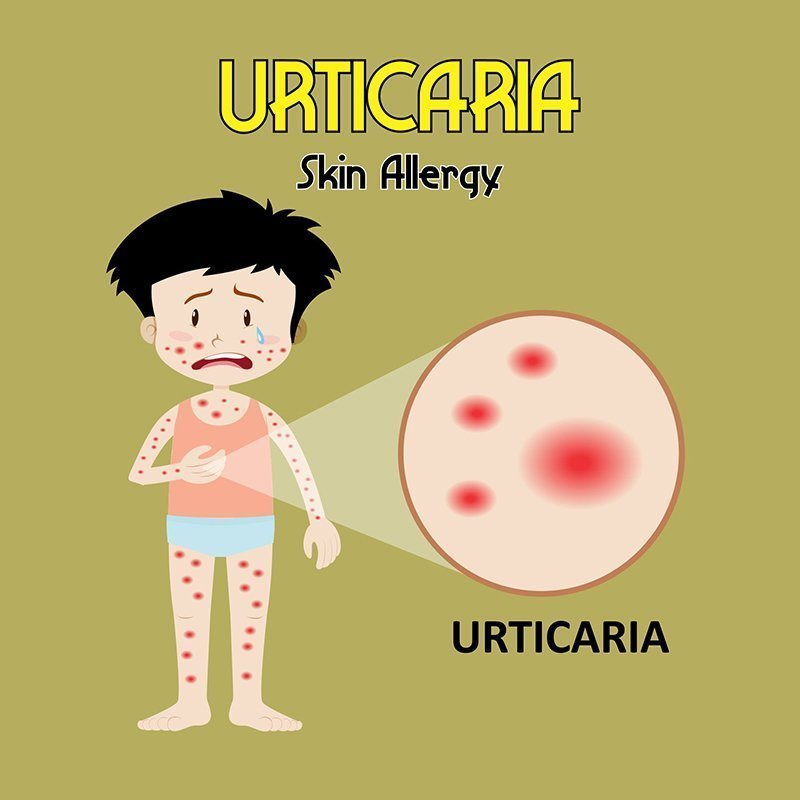
What is Urticaria
Hives are a red, raised, itchy skin rash that is sometimes triggered by an allergen. An allergen is something that produces an allergic reaction. It is also known as urticaria, welts, weals, or nettle rash. When an allergic reaction occurs, the body releases a protein called histamine. When histamine is released, the tiny blood vessels known as capillaries leak fluid. The fluid accumulates in the skin and causes a rash. Hives affect around 20 percent of people at some time in their life. It is not contagious.
Causes
Urticaria occurs when the body reacts to an allergen and releases histamine and other chemicals from under the surface of the skin. The histamine and chemicals cause inflammation and fluid to accumulate under the skin, causing wheals.

Health Tips & Info
“Stay itch-free with our expert tips on managing and preventing urticaria, for all things related to hives and allergic reactions.”
Examples of known triggers include:
Medications, including some antibiotics and non-steroidal anti-inflammatory drugs (NSAIDs), such as aspirin and ACE inhibitors, are used for high blood pressure Foods, such as nuts, shellfish, food additives, eggs, strawberries, and wheat products Infections, including influenza, the common cold, glandular fever, and hepatitis B intestinal parasites or extreme temperatures or changes in temperature Pet dander from dogs, cats, horses, and so on Pollen or latex or dust mites Some plants, including nettles, poison ivy, and poison oak Insect bites and stings Some chemicals Chronic illness, such as thyroid disease or lupus Sunlight exposure or scratching or water on the skin In half of all cases, people never find the exact cause, Chronic urticaria may start as an autoimmune response, but why it happens is unclear.
Symptoms
Swellings, known as wheals, appear as a rash on the skin. They are usually pink or red, with an oval or round shape. They can range from a few millimeters to several inches across. They can be extremely itchy, and they have a red flare around them. The wheals usually occur in batches, frequently on the face or the extremities, including the arms, hands, fingers, legs, feet, and toes. Welts normally disappear within 24 hours, but new ones may form. They can appear on just one part of the body, or on several parts. Symptoms normally disappear within 24 hours, but sometimes another weal appears as the last one fades. In some cases, hives can continue for several days. People with chronic hives can have symptoms for months or years.
Types
Hives, or urticaria, can be acute or chronic Acute urticaria is the most common type. Symptoms last less than 6 weeks, and they typically affect the face and neck, fingers, toes, and the genitals of males. However, any part of the body can be affected. Chronic urticaria continues for more than 6 weeks. About 1 in every 1,000 people is estimated to experience chronic urticaria. The exact cause is unknown, but it may link to the immune system. Viruses can also trigger hives. In some cases, it may relate to an underlying autoimmune disorder, such as thyroid disease or lupus. Angioedema may also occur. This is similar to hives, but it affects the deeper layers of the skin.
3 type of urticaria.
Acute urticaria
Share on PinterestIn acute urticaria, allergy testing can help to find a specific substance or trigger for the hives reaction.
A health professional can diagnose acute urticaria by examining the rash on the skin.
Pinpointing the trigger can help the patient prevent recurrences.
The doctor will probably ask about:
- when and where the episode began
- whether there has been an insect bite
- whether the patient lives or works in a place where potential triggers may exist, such as latex gloves, chemicals, or animals
- any medications the patient has been taking, including herbal supplements
- the patient’s medical history
- any family history of urticaria
Often, the trigger is unclear, but if there appears to be a specific trigger, the doctor may refer the patient to an allergy clinic.
Allergy clinics test the patient’s blood and skin to find out whether there is an allergy to specific substances, such as chemicals, dust mites, or some food.
Chronic urticaria
If the urticaria continues for more than 6 weeks, the trigger is probably not external, so experts do not recommend allergy tests at this point.
The following tests can check for underlying health conditions:
- blood test to check for anemia
- stool sample to identify any parasites
- erythrocyte sedimentation rate (ESR) test, to identify problems with the immune system
- thyroid function test to assess for an overactive thyroid, known as hyperthyroidism, or hypothyroidism, an underactive thyroid
- liver function tests, in case there are liver problems
Factors that may worsen the existing urticaria include:
- alcohol
- caffeine intake
- mental health issues, such as stress
Home remedies
Triggers do not cause the problem, but they can aggravate symptoms, so patients should try to identify and avoid them.
This may include:
- abstaining from or cutting down on alcohol
- avoiding certain medications
- avoiding stress, if possible, perhaps with meditation or relaxation techniques
- choosing some soaps, skin creams, and detergents that are mild.
Avoiding certain foods may help. Foods known to trigger histamine production include spinach, fish, yogurt, fish, tomato, processed, meats, chocolate, and strawberries.
Tips to reduce the irritation caused by hives include:
- wearing loose, light clothing
- avoiding scratching
- use soaps for sensitive skin
- use a shower, fan, cold water, lotion, or cool compresses to cool the area
- take an oatmeal bath with tepid water
- avoid known triggers
Some sources recommend supplements such as quercetin and evening primrose oil, vitamin C, D, and others. It is important to speak to a doctor before using supplements, as these can trigger adverse reactions.
Keeping a record of flareups can help identify a trigger.
